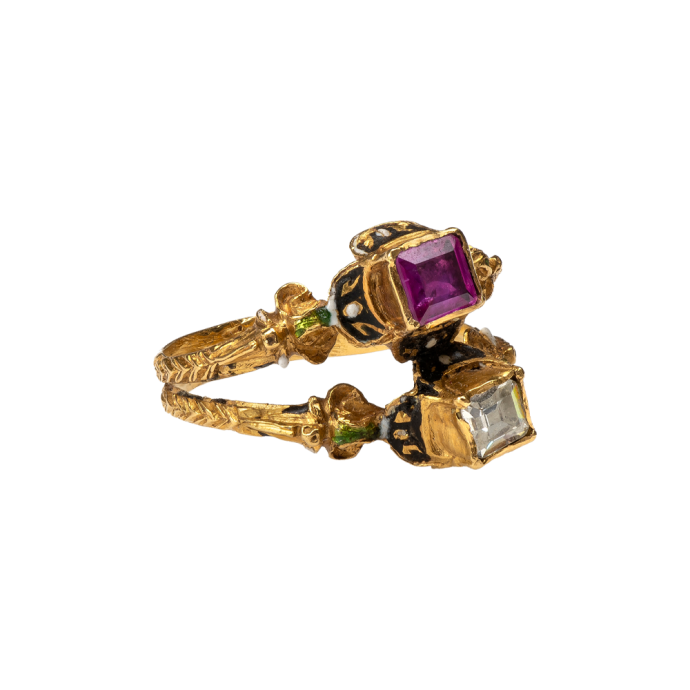


Renaissance Style Gimmel Ring
, Western Europe, 2nd half 19th century



Renaissance Style Gimmel Ring
Description
Gold twin ring is composed of two hoops which are soldered together at the base. Each hoop is of D-section with chevron ornament, formerly alternating with black enamel, the capital-shaped ends with scrolls have translucent green and opaque white enamel. Each bezel consists of a box setting with lobed sides embellished in black and white enamel and table-cut gemstones: ruby and diamond Through wear and age some enamel is missing. The ring is in good wearable condition.
Provenance:
Frédéric Spitzer (1813-1890) Collection; Ernest Guilhou (1844-1911) collection of rings, Paris; The Phyllis Phillips Collection of Medieval and Renaissance Jewellery; S.J. Phillips, London; Private Collection, Belgium.
Published:
Auct. cat. The Phyllis Phillips Medieval and Renaissance Jewellery, Christie’s, London,
13 December 1989, no. 477, 19th century.
Superb Collection of Rings formed by the Late Monsieur E. Guilhou; Sotheby's, London, 9-12 November 1937, Plate XXIV, no. 685, early 17th century.
Edmond Bonnaffé, La Collection Spitzer (1890-1892), 6 volumes, Paris 1892, vol. IV, p. 165, no. 27 and pl. 7.
Catalogue de vente de la collection Spitzer, Paris, 26 May 1893, no. 1901, described as “bague de fiançailles en or émaillié, 16 siècle”.
Literature:
During the Renaissance period in Europe rubies and diamonds and rock crystals were symbols of everlasting love and the popular choice for betrothal and wedding rings. Rubies were symbolic of love and the diamond for virtue and constancy. Portraits of the period often show the wearer posing their hand to display their marital status with a ruby or diamond ring, or even both. Such gemstone rings were either worn as a single stone or set in two interlocking twin rings, also known as gimmel rings. The never-ending form of the ring is emblematic of the eternal marital vow and the interlocking of the inextricable union. Both design and the enamel ornaments here show an adaptation of the Renaissance concept. For the love symbolism and 16th and 17th century examples of the type, cf. Beatriz Chadour-Sampson, The Power of Love, Jewels, Romance and Eternity, London 2019, pp. 42-43; fig. 3.3a, b; Scarisbrick 1993, pp. 62-63; Scarisbrick 2004, nos. 169, 170, 223; Scarisbrick 2007, figs. 97, 98; Church, 2011, fig. 46.
Exceptional is the provenance of the ring. The ring originally belonged to the eminent Austrian born art dealer and collector Frédéric Spitzer (1813-1890), who was active in Paris (Paola Cordera, La fabbrica del Rinascimento: Frédéric Spitzer mercante d’arte e collezionista nell’Europa delle nuove nazioni, Bologna 2014). Later the ring became part of the distinguished ring collection collated by Ernest Guilhou (1844-1911), a wealthy ironmaster in France. His collection comprised of 1,636 rings, which were published in 1912, and later auctioned by his family at Sotheby’s, London, in 1937 (Beatriz Chadour-Sampson and Sandra Hindman, Rings around the World, Les Enluminures, Exhibition: London, New York, 2016, no. 20, p. 130). The ring was later acquired by the artist and passionate collector of medieval and Renaissance jewelry Phyllis Phillips. When her collection was sold by Christie’s, London, in 1989, the ring was catalogued as nineteenth century.